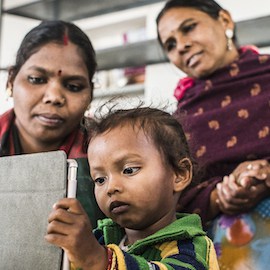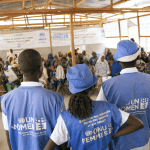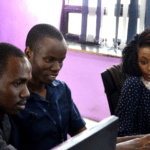The Under-Recognized Threat of ‘Ultra-Poverty’ – And How the World Can Tackle It
While there has been a great deal of progress over the last 40 years toward ending extreme poverty, the reality remains that the global community is in grave danger of missing Sustainable Development Goal 1 (SDG1) to end poverty in all its forms everywhere by 2030.
In order to rally the world to immediately prioritize reaching those living in the most severe forms of deprivation on the planet – what is termed “ultra-poverty” – we recently released a first-of-its-kind analysis dedicated exclusively to studying this extreme form of impoverishment. The inaugural Global State of Ultra-Poverty (GSUP) highlights the urgent need to combat this drastic type of destitution.
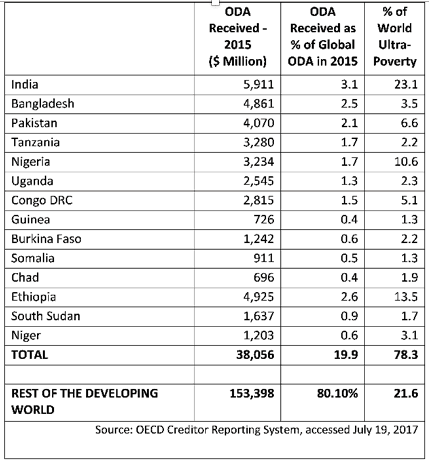
Analysis by our two organizations, RESULTS and Uplift, found that there are 394 million people living in “ultra-poverty,” with 80 percent of these individuals living in 14 countries in Africa and Asia. Worse, those 14 countries receive a mere 20 percent of official development assistance.
Most of those living in ultra-poverty are subsisting well below the “extreme poverty” line ($1.90/day, according to the World Bank). This means that these populations face the most difficult and deepest forms of poverty to address. The GSUP issues a crucial warning that the global community must act urgently to invert the prioritization and place ultra-poverty at the head of poverty eradication efforts, in order to achieve the first Sustainable Development Goal.
Through the GSUP we have set out to, among other things: (1) concretely define and categorize the deprivations that constitute ultra-poverty; (2) identify where ultra-poverty is concentrated; (3) establish those countries where ending ultra-poverty is most and least attainable; and (4) put forth recommendations for the most promising multi-sector actions that will be required to end it. The GSUP platform also provides an interactive index of the 56 countries where 1 percent or more of the population face ultra-poverty, an in-depth report and expert insights examining current evidence-backed interventions, and specific calls to action for the global community.
The GSUP notes that those living in ultra-poverty make up roughly half of the 767 million people who the World Bank calculates live in extreme poverty. The GSUP takes a more multidimensional approach to understanding the conditions that define ultra-poverty by borrowing from what the Oxford Poverty and Human Development Institute utilizes for its Multidimensional Poverty Index (MPI).
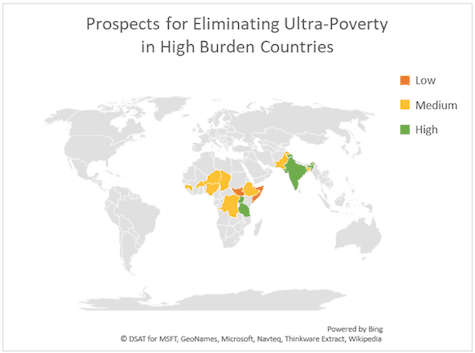
These households face a unique degree of economic and social isolation that has excluded them from most existing government and market-based extreme poverty-eradication efforts and kept them caught in an intergenerational poverty trap. Put more simply, these families are persistently hungry, their children are dying, they have no way to make a living and they have largely been overlooked by the movement to end poverty.
Most of the progress made in reducing extreme poverty in the last four decades came from moving those living just below the $1.90 per day line to just above it, primarily in China and India. The GSUP shows the majority of people currently living in extreme poverty come from countries in Africa and Asia. These communities live in the more severe and difficult circumstances that constitute ultra-poverty. Therefore, without immediate concerted and targeted interventions concerning ultra-poverty, the progress trend line will flatten.
How does progress continue toward attaining the SDG1 goal? The GSUP analysis points to two significant reasons for hope, despite the overwhelming challenge presented by the global scale of ultra-poverty.
First, there are evidence-based approaches that have been proven to support households on their journey out of ultra-poverty, such as government social payments structures and the Graduation Model pioneered by BRAC. The latter combines careful targeting, living stipends, access to health care, nutrition, training, livelihood development, asset transfers and regular mentoring. BRAC has now graduated more than 1.7 million people through this two-year program, with more than 90 percent able to maintain and expand their livelihoods, even years after leaving the program. The approach is one of the very few evidence-based programs that have been proven to reach – and empower – those living in ultra-poverty over a sustained period.
Scaling up investments in implementing, adapting and innovating these comprehensive ultra-poverty approaches is a feasible and promising pathway to accelerating the end of ultra-poverty.
Second, targeted intervention and resource allocation directed toward the 14 priority countries identified can yield extremely high impact. The real promise here is finding opportunities to employ the graduation approach within government-led national programs – combining asset transfers, training and mentoring within their existing social protection programs that provide living stipends, public works, health care and education.
Other countries are taking notice, and more than 20 national government programs are already under way, piloting or moving toward scaling this more comprehensive and intersectional approach.
This is an exciting start. Based on the data and analysis, the GSUP calls for the following multi-sector actions that are also crucial to continued success:
- The 14 countries with a high burden of ultra-poverty must specifically identify affected populations and develop new – or amend existing – national-level plans to address their needs
- Donor countries and bilateral agencies must prioritize funding for countries with the highest burden of ultra-poverty
- The World Bank must specifically address ultra-poverty within country strategies and proactively encourage countries to seek World Bank financing for programs to reach persons in the deepest poverty
- Philanthropists must support pilots, innovations, and scale-ups of evidence-backed interventions for the ultra-poor, with emphasis on the 14 high-burden countries identified in this report
- Investors must provide investment capital for the implementation of innovations such as impact bonds to accelerate the scaling of ultra-poverty programming, with special prioritization on the 14 high-burden countries identified in this report
Carolina Trivelli, former minister of social protection in Peru who helped lead that country’s transition to this approach, said that this must become the “new normal for how we think of social protection.”
We urge you to explore the GSUP platform and read our full report, explore the index and the insights on the GSUP, and join us on our campaign to #EndUltraPoverty. You can do that by driving your communities to the GSUP via your communications channels, disseminating its findings and aligning your organization with the multi-sector calls to action the GSUP identifies.
Jesse Marsden is the chief of staff, Veronica Brown is the program coordinator for Ultra Poverty and Social Protection, and Aaron Merchen is the senior associate for Global Policy and Advocacy at RESULTS.
Photo by Jaimin Desai via Unsplash.
- Categories
- Impact Assessment
